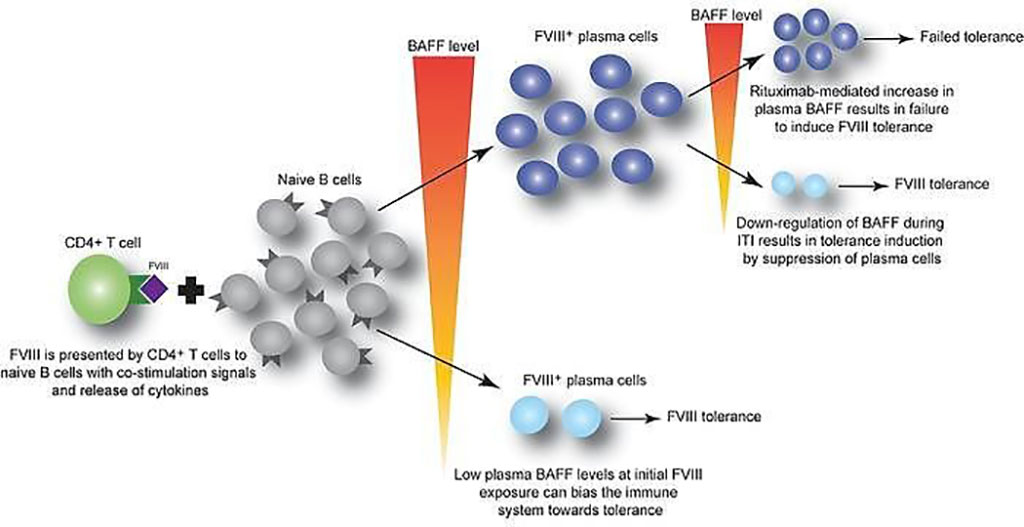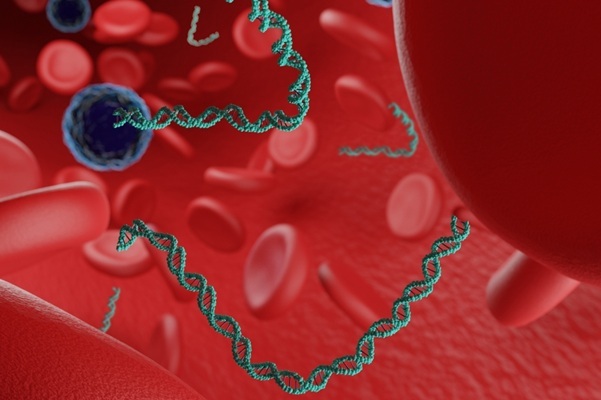Cytokine Target Identified for Treatment-Resistant Hemophilia A
|
By LabMedica International staff writers Posted on 04 May 2021 |

Image: B cell–activating factor modulates the factor VIII immune response in hemophilia A (Photo courtesy of Children’s Hospital of Philadelphia)
Hemophilia A, also called factor VIII (8) deficiency or classic hemophilia, is a genetic disorder caused by missing or defective factor VIII (FVIII), a clotting protein. Although it is passed down from parents to children, about 1/3 of cases found have no previous family history.
Currently, hemophilia is the most common inherited bleeding disorder, which affects 1 in 10,000 men across the globe. Since patients lack coagulation factor VIII (FVIII), therapies are typically aimed at infusions to replace the missing protein. Some patients, however, become treatment resistant due to the development of neutralizing antibodies, or FVIII inhibitors.
An international team of hematologists and their associates led by those at the Children’s Hospital of Philadelphia (Philadelphia, PA, USA) used plasma samples from 69 pediatric patients undergoing recombinant FVIII therapy, in addition to samples from mouse models, to determine whether cytokine B cell activating factor (BAFF) may help generate and sustain FVIII antibodies. Of the pediatric patients, 24 had FVIII inhibitors.
BAFF, proliferation-inducing ligand (APRIL), and B cell maturation antigen (BCMA) levels from the patient samples were measured by a multiplex ELISA Because of limitations on sample transport, BAFF levels from rituximab-exposed patients were measured by ELISA (R&D Systems, Minneapolis, MN, USA). The frequency of FVIII-specific immunoglobulin-secreting B cells was quantified by a B cell ELISPOT assay. Plates were analyzed using the ImmunoSpot system (Cellular Technology Limited, Shaker Heights, OH, USA).
The team reported that BAFF levels to be higher in patients with persistent FVIII inhibitors compared to those without inhibitors (1.30 versus 0.99 ng/mL, respectively). Moreover, BAFF levels decreased from baseline in hemophilia A inhibitor patients who underwent immune tolerance induction (ITI) and achieved FVIII tolerance from 1.43 ± 0.63 to 0.81 ± 0.32 ng/mL. In comparison, those who failed ITI had steady levels at 1.33 to 1.23 ng/mL. A similar pattern and trend in BAFF levels was also noted for 46 adults, although non-inhibitor patients saw a generally higher level of BAFF. Furthermore, a receiver-operating characteristic (ROC) analysis of the pooled pediatric and adult data showed that BAFF levels greater than 1.03 ng/mL had 68.3% sensitivity, 63.8% specificity, and likelihood ratio of 1.89 for the presence of FVIII inhibitors.
Valder R. Arruda, MD, PhD, a Hematologist and senior author of the study, said, “Our data suggest that BAFF may regulate the generation and maintenance of FVIII inhibitors, as well as anti-FVIII B cells. Given that an FDA-approved anti-BAFF antibody is currently used to suppress the immune response in autoimmune diseases, future studies should explore the use of this treatment in combination with rituximab to achieve better outcomes for hemophilia A patients resistant to FVIII protein replacement therapy.”
The authors concluded that their data suggest that BAFF may regulate the generation and maintenance of FVIII inhibitors and/or anti-FVIII B cells. Finally, antiCD20/anti-BAFF combination therapy may be clinically useful for ITI. The study was published on April 15, 2021 in The Journal of Clinical Investigation.
Related Links:
Children’s Hospital of Philadelphia
R&D Systems
Cellular Technology Limited
Currently, hemophilia is the most common inherited bleeding disorder, which affects 1 in 10,000 men across the globe. Since patients lack coagulation factor VIII (FVIII), therapies are typically aimed at infusions to replace the missing protein. Some patients, however, become treatment resistant due to the development of neutralizing antibodies, or FVIII inhibitors.
An international team of hematologists and their associates led by those at the Children’s Hospital of Philadelphia (Philadelphia, PA, USA) used plasma samples from 69 pediatric patients undergoing recombinant FVIII therapy, in addition to samples from mouse models, to determine whether cytokine B cell activating factor (BAFF) may help generate and sustain FVIII antibodies. Of the pediatric patients, 24 had FVIII inhibitors.
BAFF, proliferation-inducing ligand (APRIL), and B cell maturation antigen (BCMA) levels from the patient samples were measured by a multiplex ELISA Because of limitations on sample transport, BAFF levels from rituximab-exposed patients were measured by ELISA (R&D Systems, Minneapolis, MN, USA). The frequency of FVIII-specific immunoglobulin-secreting B cells was quantified by a B cell ELISPOT assay. Plates were analyzed using the ImmunoSpot system (Cellular Technology Limited, Shaker Heights, OH, USA).
The team reported that BAFF levels to be higher in patients with persistent FVIII inhibitors compared to those without inhibitors (1.30 versus 0.99 ng/mL, respectively). Moreover, BAFF levels decreased from baseline in hemophilia A inhibitor patients who underwent immune tolerance induction (ITI) and achieved FVIII tolerance from 1.43 ± 0.63 to 0.81 ± 0.32 ng/mL. In comparison, those who failed ITI had steady levels at 1.33 to 1.23 ng/mL. A similar pattern and trend in BAFF levels was also noted for 46 adults, although non-inhibitor patients saw a generally higher level of BAFF. Furthermore, a receiver-operating characteristic (ROC) analysis of the pooled pediatric and adult data showed that BAFF levels greater than 1.03 ng/mL had 68.3% sensitivity, 63.8% specificity, and likelihood ratio of 1.89 for the presence of FVIII inhibitors.
Valder R. Arruda, MD, PhD, a Hematologist and senior author of the study, said, “Our data suggest that BAFF may regulate the generation and maintenance of FVIII inhibitors, as well as anti-FVIII B cells. Given that an FDA-approved anti-BAFF antibody is currently used to suppress the immune response in autoimmune diseases, future studies should explore the use of this treatment in combination with rituximab to achieve better outcomes for hemophilia A patients resistant to FVIII protein replacement therapy.”
The authors concluded that their data suggest that BAFF may regulate the generation and maintenance of FVIII inhibitors and/or anti-FVIII B cells. Finally, antiCD20/anti-BAFF combination therapy may be clinically useful for ITI. The study was published on April 15, 2021 in The Journal of Clinical Investigation.
Related Links:
Children’s Hospital of Philadelphia
R&D Systems
Cellular Technology Limited
Latest Hematology News
- MRD Tests Could Predict Survival in Leukemia Patients
- Platelet Activity Blood Test in Middle Age Could Identify Early Alzheimer’s Risk
- Microvesicles Measurement Could Detect Vascular Injury in Sickle Cell Disease Patients
- ADLM’s New Coagulation Testing Guidance to Improve Care for Patients on Blood Thinners
- Viscoelastic Testing Could Improve Treatment of Maternal Hemorrhage
- Pioneering Model Measures Radiation Exposure in Blood for Precise Cancer Treatments
- Platelets Could Improve Early and Minimally Invasive Detection of Cancer
- Portable and Disposable Device Obtains Platelet-Rich Plasma Without Complex Equipment
- Disposable Cartridge-Based Test Delivers Rapid and Accurate CBC Results
- First Point-of-Care Heparin Monitoring Test Provides Results in Under 15 Minutes

- New Scoring System Predicts Risk of Developing Cancer from Common Blood Disorder
- Non-Invasive Prenatal Test for Fetal RhD Status Demonstrates 100% Accuracy
- WBC Count Could Predict Severity of COVID-19 Symptoms
- New Platelet Counting Technology to Help Labs Prevent Diagnosis Errors
- Streamlined Approach to Testing for Heparin-Induced Thrombocytopenia Improves Diagnostic Accuracy
- POC Hemostasis System Could Help Prevent Maternal Deaths
Channels
Clinical Chemistry
view channel
Noninvasive Blood-Glucose Monitoring to Replace Finger Pricks for Diabetics
People with diabetes often need to measure their blood glucose multiple times a day, most commonly through finger-prick blood tests or implanted sensors. These methods can be painful, inconvenient, and... Read more
POC Breath Diagnostic System to Detect Pneumonia-Causing Pathogens
Pseudomonas aeruginosa is a major cause of hospital-acquired and ventilator-associated pneumonia, particularly in lung transplant recipients and patients with structural lung disease. Its ability to form... Read moreMolecular Diagnostics
view channel
Endometriosis Blood Test Could Replace Invasive Laparoscopic Diagnosis
Endometriosis affects an estimated 1 in 10 women globally, yet diagnosis can take 7 to 10 years on average due to the invasive nature of laparoscopy and lack of accurate, non-invasive tests.... Read more
World's First NGS-Based Diagnostic Platform Fully Automates Sample-To-Result Process Within Single Device
Rapid point-of-need diagnostics are of critical need, especially in the areas of infectious disease and cancer testing and monitoring. Now, a direct-from-specimen platform that performs genomic analysis... Read more
Rapid Diagnostic Breakthrough Simultaneously Detects Resistance and Virulence in Klebsiella Pneumoniae
Antibiotic resistance is a steadily escalating threat to global healthcare, making common infections harder to treat and increasing the risk of severe complications. One of the most concerning pathogens... Read moreImmunology
view channel
Ultrasensitive Liquid Biopsy Demonstrates Efficacy in Predicting Immunotherapy Response
Immunotherapy has transformed cancer treatment, but only a small proportion of patients experience lasting benefit, with response rates often remaining between 10% and 20%. Clinicians currently lack reliable... Read more
Blood Test Could Identify Colon Cancer Patients to Benefit from NSAIDs
Colon cancer remains a major cause of cancer-related illness, with many patients facing relapse even after surgery and chemotherapy. Up to 40% of people with stage III disease experience recurrence, highlighting... Read moreMicrobiology
view channel
New UTI Diagnosis Method Delivers Antibiotic Resistance Results 24 Hours Earlier
Urinary tract infections affect around 152 million people every year, making them one of the most common bacterial infections worldwide. In routine medical practice, diagnosis often relies on rapid urine... Read more
Breakthroughs in Microbial Analysis to Enhance Disease Prediction
Microorganisms shape human health, ecosystems, and the planet’s climate, yet identifying them and understanding how they are related remains a major scientific challenge. Even with modern DNA sequencing,... Read morePathology
view channel
AI Tool Simultaneously Identifies Genetic Mutations and Disease Type
Interpreting genetic test results remains a major challenge in modern medicine, particularly for rare and complex diseases. While existing tools can indicate whether a genetic mutation is harmful, they... Read more
Rapid Low-Cost Tests Can Prevent Child Deaths from Contaminated Medicinal Syrups
Medicinal syrups contaminated with toxic chemicals have caused the deaths of hundreds of children worldwide, exposing a critical gap in how these products are tested before reaching patients.... Read more
Tumor Signals in Saliva and Blood Enable Non-Invasive Monitoring of Head and Neck Cancer
Head and neck cancers are among the most aggressive malignancies worldwide, with nearly 900,000 new cases diagnosed each year. Monitoring these cancers for recurrence or relapse typically relies on tissue... Read moreTechnology
view channel
AI Predicts Colorectal Cancer Survival Using Clinical and Molecular Features
Colorectal cancer is one of the most common and deadly cancers worldwide, and accurately predicting patient survival remains a major clinical challenge. Traditional prognostic tools often rely on either... Read more
Diagnostic Chip Monitors Chemotherapy Effectiveness for Brain Cancer
Glioblastoma is one of the most aggressive and fatal brain cancers, with most patients surviving less than two years after diagnosis. Treatment is particularly challenging because the tumor infiltrates... Read moreIndustry
view channel
BD and Penn Institute Collaborate to Advance Immunotherapy through Flow Cytometry
BD (Becton, Dickinson and Company, Franklin Lakes, NJ, USA) has entered into a strategic collaboration with the Institute for Immunology and Immune Health (I3H, Philadelphia, PA, USA) at the University... Read more









 Analyzer.jpg)











